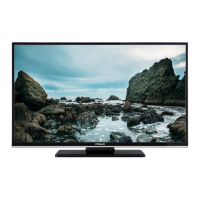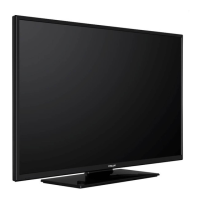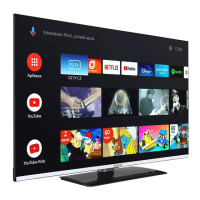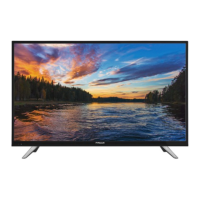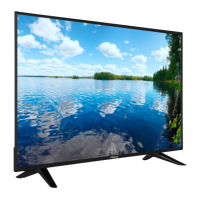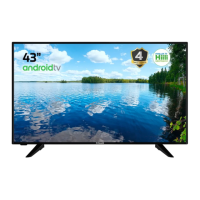Do you have a question about the Finlux 47FLSKR910LH and is the answer not in the manual?
Guidelines for safe electrical power connection and cord management.
Warnings regarding water, heat, flames, and lightning exposure.
Procedures for cleaning, ventilation, parts replacement, servicing, and waste disposal.
EU user info, safe disconnection, and headphone volume warning.
Guidelines for secure wall mounting and LCD screen characteristics.
Safety precautions for connecting to TV distribution systems.
Warnings about children using electrical devices and general safety.
Options for reducing energy consumption via Power Save Mode settings.
Information on servicing and contacting the dealer for repairs.
Detailed explanation of each button's function on the remote control.
Explanation of TV set buttons and standby operation.
Identification and description of rear panel input/output ports.
Using CI slots and connecting USB devices via side ports.
Connecting HDMI, headphones, and AV devices via side ports.
How to connect the aerial or cable TV plug to the TV.
Connecting the TV to the mains and acclimating to room temperature.
Connecting USB drives, device compatibility, and formatting.
Steps and requirements for recording programmes using USB.
How to connect devices with HDMI via the side port.
Connecting a PC for display and audio output.
Methods for connecting a DVD player via HDMI, Component, or SCART.
Connecting cameras or camcorders using side AV inputs.
Connecting devices with SPDIF support for audio output.
Steps to connect the TV to a wired LAN network.
Requirements and steps for connecting to a wireless network.
Instructions for inserting batteries into the remote control.
Procedures for powering the TV on and off via remote or buttons.
Displays on-screen messages related to standby status.
How to activate and use digital teletext features.
Guidance on using analogue teletext functions.
How to switch between different input sources like HDMI, AV, etc.
Adjusting volume and selecting programmes using TV buttons or remote.
How to access and navigate the Electronic Programme Guide.
How to record programmes directly from the EPG interface.
Accessing event options from the EPG menu.
Setting, managing, and cancelling programme recordings and timers.
Guide for the initial setup and channel scanning process.
Performing an automatic scan to find and store TV channels.
Explanation of different scan types like Digital Aerial.
Using manual tuning for specific channel searches.
Performing scans via network connections.
Adjusting analogue channels for optimal reception.
How to clear the list of stored TV channels.
Editing, viewing, and filtering stored channels.
Procedures for managing individual channels in the list.
Filtering, sorting channels, and managing favorite lists.
Sorting channels by broadcast type and managing active lists.
How to view current channel and programme details.
How to launch and navigate the Media Browser.
How to play video files from a USB device.
How to view photos and use slideshow features.
Controls for pausing, continuing, and rotating slideshow images.
How to play music files from a USB device.
How to view and play back recorded programmes.
Setting options for view style, subtitle, and language.
How to pause and record live broadcasts simultaneously.
How to start recording a programme immediately.
Controls for playing back recorded content.
How to change image size using different picture formats.
Setting picture modes, contrast, brightness, and sharpness.
Fine-tuning picture quality with advanced options.
Specific settings for connecting and displaying a PC.
Adjusting volume, equalizer, balance, and sound modes.
Navigating and understanding the main TV settings menu.
How to insert and use a CAM module for digital channels.
Accessing and understanding the Conditional Access menu.
Setting system, audio, subtitle, and teletext languages.
Enabling menu lock, maturity lock, child lock, and setting PIN.
Setting timers for turning off the TV or recording programmes.
Configuring recording settings like start/end times and disk formatting.
Displaying information about the connected USB disk.
Setting the TV's date, time, and time zone.
Enabling or disabling selected input sources.
Setting up wired network connections and checking status.
Fine-tuning wired network settings in advanced mode.
Configuring various TV preferences like menu timeout and accessibility.
Showing programme number, name, sound indicator, etc.
Using mute function and changing picture modes.
Enabling or disabling subtitle display.
Using teletext buttons for navigation and information.
Using coloured buttons for FASTEXT and TOP text systems.
Advice on cleaning the screen and handling image persistence.
Troubleshooting common power, picture, and sound problems.
Resolving issues with remote control or input selection.
Troubleshooting recording problems and USB speed errors.
Table of typical video display modes for PC input.
Compatibility of AV and HDMI signal types.
Table of supported DVI resolutions via converter cables.
List of file formats supported for USB playback.
Different ways to search for and install software upgrades.
Details on TV broadcasting standards and receiving channels.
Specifications for audio output power and maximum power consumption.
Panel type, screen size, and physical dimensions.
Technical standards for digital reception (DVB-T, DVB-C, DVB-T2).
| Screen Size | 47 inches |
|---|---|
| Backlight Technology | LED |
| Refresh Rate | 50 Hz |
| Smart TV | Yes |
| HDMI Ports | 3 |
| USB Ports | 2 |
| Built-in Wi-Fi | Yes |
| Display Resolution | 1920x1080 |


